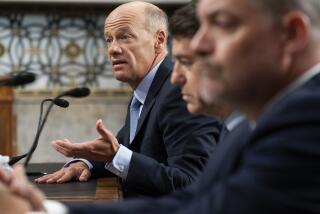GAO Warns of Bank Failures, Federal Bailout
- Share via
WASHINGTON — The General Accounting Office warned Tuesday that the nation’s banking system is in such fragile condition that a recession could bring on the failure of several major banks, wiping out the federal deposit insurance fund and making a taxpayer bailout necessary.
In unusually pessimistic testimony, Comptroller General Charles A. Bowsher, the head of the agency, told the Senate Banking, Housing and Urban Affairs Committee that the banking industry is plagued by billions of dollars in losses not yet identified by federal regulators.
“Not since its birth during the Great Depression has the federal system of deposit insurance for commercial banks faced such a period of danger and uncertainty as it does today,” Bowsher said.
His warning was prompted by a new GAO study of 300 large and troubled banks that identified 35 institutions as in danger of failing within a year, with potential total losses ranging from $4.4 billion to $6.3 billion. Those figures would take a massive bite out of the insurance fund, which had dwindled to $13 billion at the end of last year.
The bank insurance fund protects deposits of as much as $100,000 and has the ultimate support of Congress and the President, who have pledged that insured depositors will not lose a penny.
Keeping that promise in the case of savings and loan deposits will cost the taxpayers between $90 billion and $130 billion, without including the future cost of interest on the bonds sold to shut insolvent S&Ls; and pay off their depositors. Federal officials now say that it may be necessary to keep some weak thrifts open under close government supervision to avoid adding to the rising cost of the financial rescue operation.
The banking industry generally is considered much healthier than the ravaged S&Ls;, but Bowsher’s strongly worded testimony Tuesday warned of possibly dangerous problems ahead.
L. William Seidman, the man who runs the deposit guarantee system as chairman of the Federal Deposit Insurance Corp., has told Congress that the fund is under stress and could lose $2 billion or more this year. However, Bowsher was much gloomier Tuesday, describing a disaster waiting to happen and suggesting that Seidman’s corps of bank examiners has not found the real extent of bank losses.
Federal officials must “dig deeper” in examining the banks, Bowsher said, calling for on-site examinations of problem institutions on an annual basis and for more frequent certified reports by accountants on banks’ financial health.
Bankers quickly moved to dispel any linkage between their industry and problems of the S&L; business.
“You can’t equate it to the situation in the savings and loan industry--they are totally distinct,” John W. Spiegel, chief financial officer of SunTrust Banks, based in Atlanta, said after an American Bankers Assn. press conference in New York on the industry’s health.
The number of banks on the government’s problem list dropped to 1,000 last year, down from nearly 1,600 in 1987, according to Spiegel.
“The biggest, most significant thing is that banking institutions are diversified in nature compared to thrifts,” he said.
The GAO study discovered 35 impaired banks, situated principally in the Northeast and Southwest, with a high risk of failure. Bowsher did not identify the banks but said that none are among the nation’s 10 largest banks.
About 15 of the 35 banks had failed as of Aug. 13; and, if all collapsed into insolvency, the losses could run as high as $6.3 billion, according to the GAO. “A significant number of other banks,” also primarily in the Northeast and Southwest, “are at risk to fail within the next few years, particularly if their regional economies continue to deteriorate,” Bowsher said.
Failure of the sick 35 institutions and the other weak regional banks would “severely” injure the insurance fund, which has dropped by $5 billion in the last two years.
“A recession could exacerbate this problem, causing failure of other large banks beyond those we have identified, exhausting the fund and resulting in a taxpayer bailout,” Bowsher warned.
His testimony appeared to startle members of the Banking Committee, who seemingly had become inured to bad news about the ever-mounting cost of the thrift crisis.
“You’ve given us a very serious warning,” said the committee chairman, Sen. Donald W. Riegle Jr. (D-Mich.). “We have got to take steps to deal with the problem. There is a lot of phony accounting and failure to recognize true costs.”
Sen. Jake Garn (R-Utah), the committee’s ranking Republican and a former chairman, said: “I don’t want to be part of another fiasco.”
“The public is obviously concerned about Iraq . . . but there is not a more important issue than the strength of our financial structure and the economy,” Sen. John Kerry (D-Mass.) said.
On the House side, Rep. Frank Annunzio (D-Ill.) said that he will offer legislation requiring banks to increase their contributions to the insurance fund by $23 billion. “Perhaps now we can get some action to beef up the bank insurance fund,” said Annunzio, chairman of the financial institutions subcommittee of the House Banking, Finance and Urban Affairs Committee.
“We must act immediately to make certain that the bank insurance fund does not require a taxpayer bailout,” he said.
Staff writer James Bates contributed to this story from Los Angeles.
More to Read
Sign up for Essential California
The most important California stories and recommendations in your inbox every morning.
You may occasionally receive promotional content from the Los Angeles Times.













